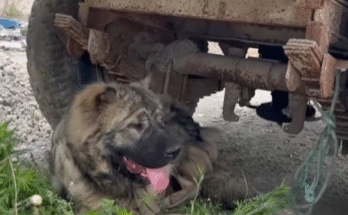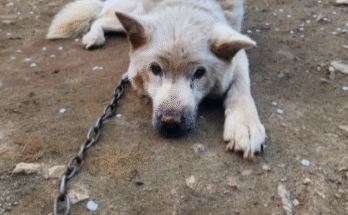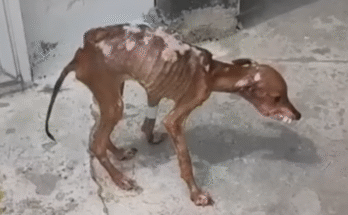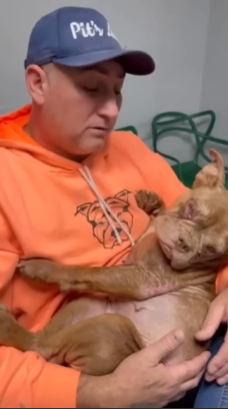
The first time I saw her, she didn’t lift her head. She didn’t bark, didn’t growl, didn’t even flinch. She simply sat curled in the farthest corner of a rusted cage, her frail body folded into itself as though trying to disappear. Dogs in the surrounding cages barked or wagged their tails, hoping for attention. But not her. She was silent, still, and heartbreakingly small.
Her fur was matted and missing in patches. Her ribs pressed against her thin skin like sharp lines. Her paws were swollen, her tail limp, her ears scarred. But what stopped me in my tracks was her eyes—or rather, the emptiness where sight should have been. Cloudy. Faded. Lost.
I asked the shelter worker about her.
They sighed. “She’s been used for breeding her entire life. A puppy mill dog. Never loved, never held. When she stopped producing litters, they dumped her in a cardboard box outside our gate. She’s blind. Her joints are damaged. She’s terrified of people.”
Then, more quietly, “We don’t know how much longer she has.”
My heart cracked.
I knelt beside her cage and spoke softly, “Hey, sweetheart…”
Nothing. Not even a twitch. It was as though she’d already given up on life.
But I hadn’t given up on her.
I opened the cage door slowly, careful not to startle her. The smell of neglect—urine, fear, dirt—hit me hard. When I reached out, she shrank back, trembling so violently that her whole tiny body shook.
“It’s okay,” I whispered, keeping my hand still, letting her sniff the air. “I won’t hurt you.”
She hesitated for a long time. Then, with a movement so frail it nearly broke me, she lowered her head just enough for my fingers to brush gently under her chin.
It was like touching a ghost.
I lifted her carefully, her bones far too light, far too fragile. She tensed at first, her breath quick and panicked. But when she realized she wasn’t being restrained or forced, she let out a tiny exhale and rested her head against my chest.
And that was the moment I knew she was coming home with me.
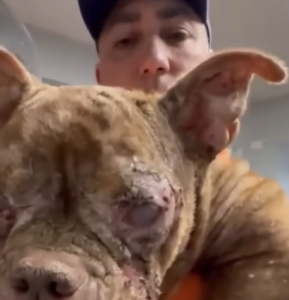
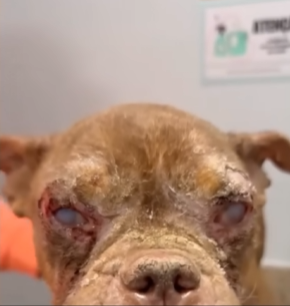
The car ride was quiet, except for her occasional whimpers when the world outside made unfamiliar sounds. I held her the whole way, stroking her back lightly. Each time I moved my hand away, she pressed closer, as if silently begging me not to let go.
When we got home, I prepared a soft bed for her with blankets and heating pads. She explored the room slowly, bumping into furniture gently, sniffing cautiously, her movements slow and hesitant. Every few seconds, she turned her head in my direction, not seeing me but sensing me—listening for my breathing, my footsteps, anything to anchor her to safety.
I cooked soft, warm food and sat on the floor beside her while she ate. She struggled, chewing carefully with worn-down teeth, but she ate—maybe because for the first time in her life, someone was watching over her with care instead of cruelty.
Later that night, I lay on the floor next to her bed. She hesitated, then gently crawled closer until her tiny body touched my arm. She rested her head against me.
I didn’t move.
I didn’t breathe.
I let her come to me on her own terms.
And when her trembling slowed and her breaths became soft and steady, I knew she had finally fallen asleep.
Over the next days, her true story revealed itself piece by piece—not through words, but through scars, habits, and fears.
She flinched every time a door closed too loudly.
She froze whenever I lifted my hand, even if it was just to scratch my head.
She never barked. Not once. She had learned that silence meant survival.
Baths terrified her.
Leashes terrified her.
Being alone terrified her.
She had spent years being used, touched only out of necessity, never kindness. Her only purpose had been to produce puppies for profit. The moment she stopped being “useful,” they threw her away like garbage.
But despite everything, she wanted to trust.
Her heart, though damaged, still beat with a tiny flicker of hope.
Every day, I talked to her. Softly. Slowly. I told her she was safe, she was loved, she was home. She couldn’t see my face, but she learned my voice, my smell, the rhythm of my footsteps.
Some days she made progress—walking a little steadier, eating a little more, leaning into my touch instead of shrinking from it. Other days she stayed curled in her bed, too tired or too afraid to do much more than breathe. I let her move at her own pace.
Healing is not a straight line.
And hers was carved by years of trauma.
But she wasn’t alone anymore.
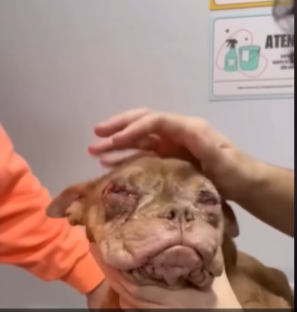
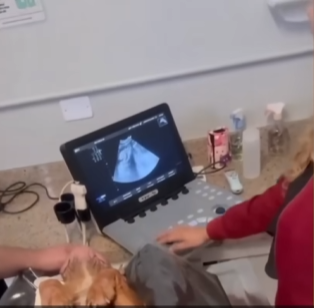
The moment everything changed came one quiet afternoon. I sat on the couch with a blanket, reading. She lay in her bed across the room, dozing lightly. Suddenly, she lifted her head, sniffled the air, and took a few uncertain steps toward me.
Her paws tapped gently on the floor as she made her way forward, guided only by sound and instinct. When she reached me, she paused. I didn’t move. I let her choose.
With great effort, she climbed onto the couch—something she’d never done before. She turned in a slow, wobbly circle, then lowered herself into my lap.
Her head rested against my chest.
Her breathing eased.
Her body relaxed completely, for the first time I had ever seen.
I wrapped my arms gently around her, feeling her ribs rise and fall against me.
And then it happened.
She fell asleep.
Deeply.
Peacefully.
Fully trusting me to hold her.
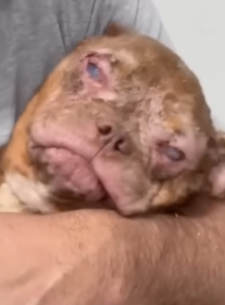
A dog who had spent her entire life blind, broken, used, discarded—finally safe enough to rest.
I cried quietly into her fur, not wanting to wake her.
She didn’t stir.
She didn’t flinch.
She wasn’t afraid.
She slept as though she had finally found the arms she’d been waiting for her whole life.
She wasn’t just a rescue.
She wasn’t just a survivor.
She was a reminder that even the most broken hearts can find healing, that warmth can reach even the coldest shadows, and that love—gentle, patient, unconditional—can save a life.
And in my arms, she finally knew what love felt like.
She had been used her whole life.
But in the end, she was cherished.
Completely.
Tenderly.
Forever.
